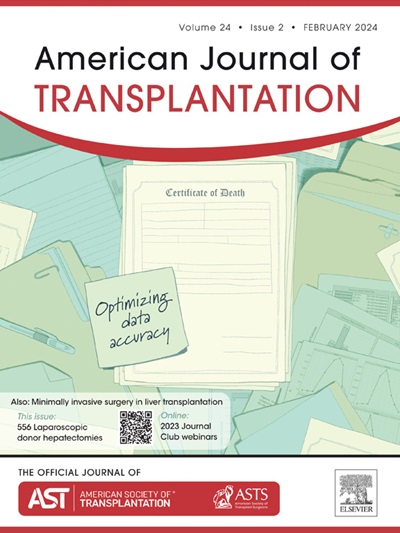Virtual crossmatching: Principles, practices, and the path forward—An American Society for Histocompatibility and Immunogenetics/College of American Pathologists collaborative
IF 8.2
2区 医学
Q1 SURGERY
引用次数: 0
Abstract
Donor-specific anti-human leukocyte antigen (HLA) antibodies are a significant barrier to solid organ transplant and can lead to poor outcomes in the posttransplant setting. Physical crossmatch (PXM), including complement-dependent cytotoxicity crossmatch and flow cytometric crossmatch, has substantially reduced the incidence of hyperacute rejection and, for years, has been the gold standard for compatibility assessment before transplant. However, the advent of solid-phase anti-HLA antibody testing and molecular HLA typing has allowed the introduction and rise of virtual crossmatch (VXM). With a high negative predictive value, VXM has proven to be more sensitive than PXM in detecting donor-specific anti-HLA antibodies. Recent regulations by the Centers for Medicare & Medicaid Services now recognize VXM as a suitable alternative to PXM in pretransplant compatibility assessment. As VXM gains acceptance, it is imperative that we understand its complexities, such as its definition, application, advantages, and disadvantages. In this review, we examine the principles underlying VXM, including both generally accepted concepts and areas under debate. Furthermore, we highlight current applications and discuss opportunities for future improvement.
虚拟交叉匹配:原则、实践和前进的道路——ASHI/CAP合作。
供体特异性抗人白细胞抗原(HLA)抗体(DSA)是实体器官移植的一个重要障碍,可能导致移植后的不良结果。物理交叉配型(PXM),包括补体依赖性细胞毒性交叉配型和流式细胞术交叉配型,大大降低了超急性排斥反应的发生率,多年来一直是移植前相容性评估的金标准。然而,固相抗HLA抗体检测和HLA分子分型的出现使得虚拟交叉配型(VXM)的引入和兴起。由于具有较高的阴性预测值,VXM已被证明在检测DSA方面比PXM更敏感。医疗保险和医疗补助服务中心最近的规定现在承认VXM是移植前相容性评估中PXM的合适替代品。随着VXM获得认可,我们有必要了解它的复杂性,例如它的定义、应用、优点和缺点。在这篇综述中,我们研究了VXM的基本原则,包括普遍接受的概念和有争议的领域。此外,我们强调了当前的应用,并讨论了未来改进的机会。
本文章由计算机程序翻译,如有差异,请以英文原文为准。
求助全文
约1分钟内获得全文
求助全文
来源期刊
CiteScore
18.70
自引率
4.50%
发文量
346
审稿时长
26 days
期刊介绍:
The American Journal of Transplantation is a leading journal in the field of transplantation. It serves as a forum for debate and reassessment, an agent of change, and a major platform for promoting understanding, improving results, and advancing science. Published monthly, it provides an essential resource for researchers and clinicians worldwide.
The journal publishes original articles, case reports, invited reviews, letters to the editor, critical reviews, news features, consensus documents, and guidelines over 12 issues a year. It covers all major subject areas in transplantation, including thoracic (heart, lung), abdominal (kidney, liver, pancreas, islets), tissue and stem cell transplantation, organ and tissue donation and preservation, tissue injury, repair, inflammation, and aging, histocompatibility, drugs and pharmacology, graft survival, and prevention of graft dysfunction and failure. It also explores ethical and social issues in the field.

 求助内容:
求助内容: 应助结果提醒方式:
应助结果提醒方式:


